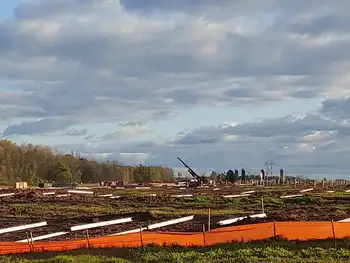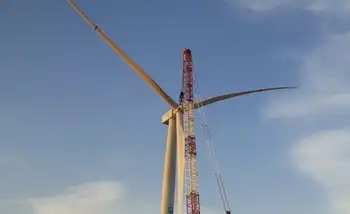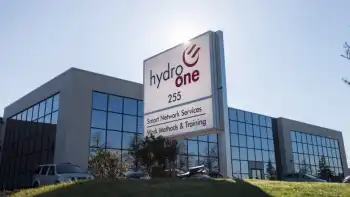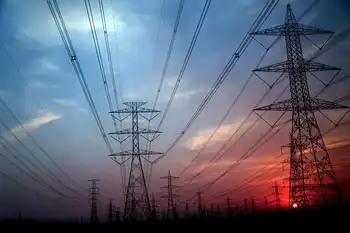Power plant's cleaning and testing puzzling neighbors
ESCONDIDO, CALIFORNIA - More than a week of billowing steam coming from a power plant under construction in western Escondido has left people who live and work nearby with plenty of questions.
How long will this go on? What is that yellow color rising into the sky? And what is that gunk on my car?
The steam started around Oct. 27, when engineers at Palomar Energy, a unit of Sempra Energy, began using steam to clean out the boiler tubes leading to the power plant's steam turbines. The 550-megawatt natural-gas-fueled plant south of Vineyard Avenue is scheduled to begin operations next summer.
A close look at the plant shows that a yellow or brown exhaust comes from a part of the power plant separate from the steam. It originates from incomplete combustion of the natural gas used to heat the water to generate the steam, project director Bob Jackson said recently.
Incomplete combustion can be expected while Sempra engineers "tune" the turbines to achieve a proper mix of fuel and air, he said. To heat the water, one of the plant's two turbines is running at 35 megawatts, or about a fifth of its full capacity of 165 megawatts.
While it appeared November 7 that exhaust had not contributed to smog around Escondido, some people who work near the power plant site said they noticed more tangible effects.
Tom Hearn, who lives to the west of the site, said he and his wife have occasionally heard a "roar that sounds like an airplane" at night.
Sempra sent out a letter before the cleaning began advising neighbors of the possibility of a "barely discernible noise." The company reported Monday that its tests on-site did not exceed 45 decibels, below the noise level of rainfall or a refrigerator.
Vicky Stanford, who works near Vineyard, said she found a milky residue on her car recently. It was similar to what remains after washing with hard water, she said.
"What else besides water is in the steam?" she asked. "Many people in my building noticed something on their cars. I'm very curious."
Andrews said the residue could have come from dust from nearby construction, but in any case Sempra is offering a free car wash to affected motorists.
"We don't know if it comes from the steam," she said. "But we appreciate the patience of the neighbors during this process."
The water used to make the steam comes from the city of Escondido's Hale Avenue sewage treatment plant and contains more dissolved calcium and magnesium salts than drinking water. However, it is "demineralized" before making the steam, Andrews said.
The company's representatives emphasized that the exhaust visible recently would not be part of normal operations once the plant opens next summer.
A catalytic converter, similar in principle to those in cars, still needs to be installed on the power plant, Jackson said. It will use ammonia to reduce the production of nitrogen oxides, which are ingredients of smog.
The $410 million plant is being built according to requirements set by the California Energy Commission in 2003. Once in full operation, the plant's production of nitrogen oxides annually are estimated at two parts per million, or one-400th of the nitrogen oxides produced every day by San Diego's cars, commission spokewoman Mary Ann Costamagna said.
In addition, a $1 million "plume abatement system" is designed to reduce the amount of steam coming from the cooling tower that has been built but is not yet in operation. The system sprays cool water across the steam coming from the cooling tower, quenching the plume, Jackson said.
To do the steam cleaning, Sempra applied to the San Diego Air Pollution Control District for a 30-day temporary permit that allows the power plant to generate more opaque exhaust than normal when in full operation. Sempra has received verbal confirmation from pollution district officials for the permit, which started retroactively Nov. 2, Andrews said.
The district is moving its office, according to its Web site.
Data from the tracking ozone and particulate matter, available on the district's Web site, do not show that Escondido has experienced an overall increase in smog in the last two weeks.
Related News

To Limit Climate Change, Scientists Try To Improve Solar And Wind Power
WASHINGTON - Solar energy in Wisconsin continued to grow in 2019, as more homeowners had rooftop panels installed and big utilities started building multi-panel solar farms.
Wind power is increasing more slowly in the state. However, developers are again coming forward with proposals for multiple turbines.
Nationally, researchers are working on ways to get even more energy from solar and wind, as states like Wisconsin aim to reduce their carbon emissions over the next few decades.
One reason solar energy is growing in Wisconsin is due to the silicon panels becoming more efficient. But scientists haven't finished trying to improve panel efficiency. The…




